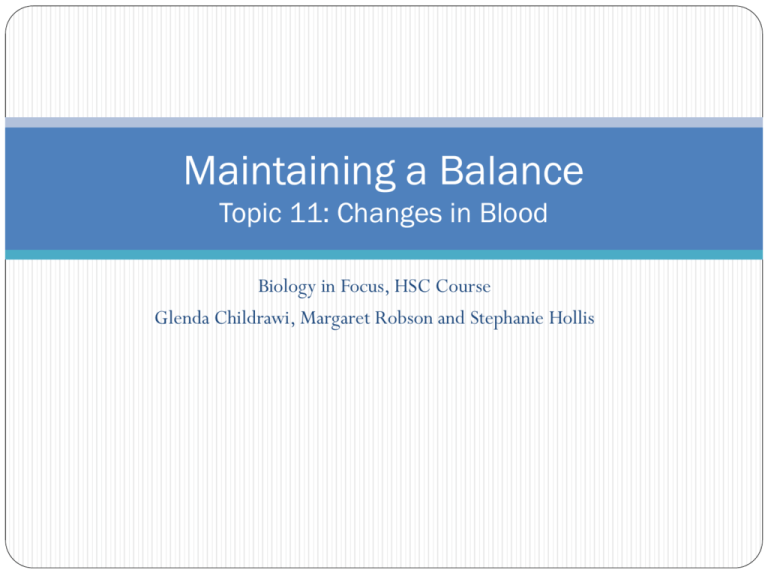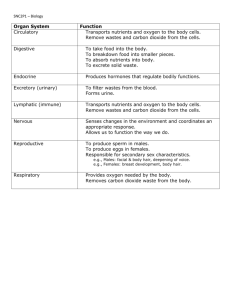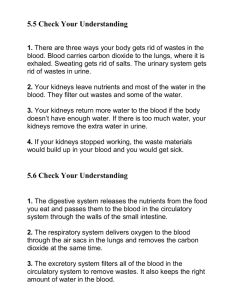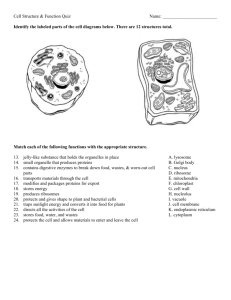Planet Earth and Its Environment A 5000-million year
advertisement

Maintaining a Balance Topic 11: Changes in Blood Biology in Focus, HSC Course Glenda Childrawi, Margaret Robson and Stephanie Hollis DOT POINT Describe the main changes in the chemical composition of the blood as it moves around the body and identify tissues in which these changes occur. Introduction The circulatory system in mammals is like a road system within a city – it is responsible for the transport of substances to and from various parts. This transport system is involved in moving four basic groups of chemicals: 1. Gases (carbon dioxide and oxygen) 2. Nutrients 3. Wastes 4. Hormones (chemical signals) nicenfunny.com Assisting Metabolism The chemical functioning of cells (metabolism) relies on the correct balance of chemical reactants being brought to cells and the removal of wastes produced. wisdomsofhealth.com Assisting Metabolism Energy is the basis of all metabolic functioning – for any cell to function it must produce the energy it requires by means of cellular respiration. This energy production depends on the correct balance of nutrients such as glucose and the gas oxygen arriving at the site. losebabyweight.com.au Assisting Metabolism Requirements for energy production must be transported from their source (glucose and food-based nutrients from the digestive system and oxygen from the lungs) to the sites where they are needed – the cells of the body that require energy. classes.midlandstech.com Assisting Metabolism The transport system of vessels throughout the body is essential, since the mammalian body is to large and complex to simply rely on diffusion for movement of these substances. artepolitica.com Assisting Metabolism Once the reactants reach the cells, cellular respiration occurs: oxygen is combined with glucose to produce energy in the form of ATP (the chemical energy of cells), and carbon dioxide and water are released as by-products of this process. The carbon dioxide is removed as waste. biology.iupui.edu Assisting Metabolism Nitrogenous wastes are the end products of protein breakdown that occurs during metabolic functioning. All wastes are carried from their sites of production, to organs where they can be excreted. The blood vessels are responsible for this transport of wastes, to ensure that conditions are right for enzyme functioning in metabolism. xtremepapers.com Assisting Metabolism In addition, the transport system is responsible for transporting hormones – chemical messenger molecules produced by endocrine glands. These are ductless glands and so they pour their secretions directly into the bloodstream, which transports them to their target organs. cartage.org.lb Assisting Metabolism Hormones such as those that control water and salt balance in animals are essential to assist homeostasis, ensuring the maintenance of an optimal internal environment for metabolic functioning. fineartamerica.com The Changing Composition of Blood The difference in the chemical concentration of blood entering or leaving an organ, depends on the function of that organ. External gaseous exchange occurs in the lungs. Deoxygenated blood arrives at the lungs and it releases carbon dioxide and picks up oxygen. Oxygenated blood is returned to the lungs and then columbia.edu The Changing Chemical Composition of Blood Internal gaseous exchange occurs in all organs of the body and is the result of cellular respiration. Cells release carbon dioxide, which diffuses into the blood capillaries in the tissues. bio.miami.edu The Changing Chemical Composition of Blood Absorption of nutrients into the bloodstream takes place in the digestive tract. These products of digestion travel in the bloodstream from the digestive tract directly to the liver. A decrease in digestive end products is evident once blood has passed through the liver as this is the centre of food metabolism. purushas.com The Changing Chemical Composition of Blood Nitrogenous waste products are produced in the liver and excreted by the kidneys. An increase in nitrogenous wastes is evident in blood that has passed through the liver, the organ where proteins are de-animated to form these wastes. A decrease in nitrogenous wastes is evident in blood that has passed through the kidneys, since they filter nitrogenous wastes out of the blood and excrete them. publications.nigms.nih.gov Activity/Homework Complete the Table with students in the following activity: -11.1.2 Changing Comp of Blood Worksheet




